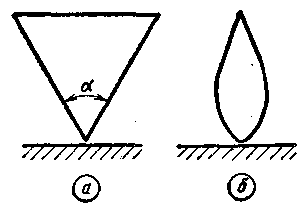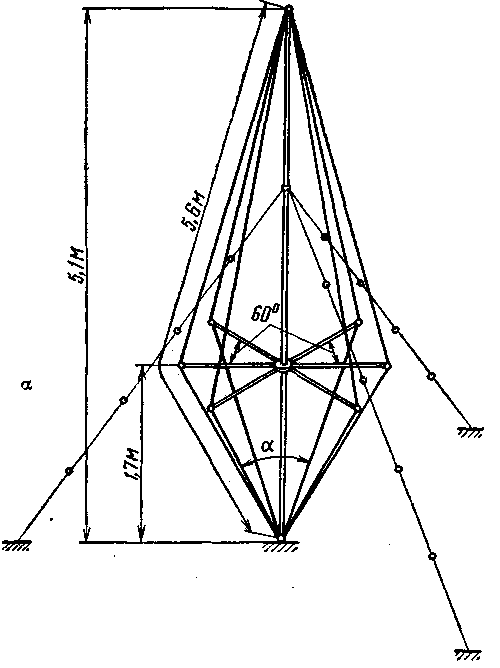Multiband vertical antenna. Encyclopedia of radio electronics and electrical engineering

Encyclopedia of radio electronics and electrical engineering / HF antennas
 Comments on the article
Comments on the article
The "Ground Plane" vertical antennas, which have become widespread among shortwavers, do not have sufficient broadband and, without additional adjustment, can only be used to operate in a narrow frequency band. The so-called "thick" vertical antennas, whose radiating surface has various shapes, are free from this disadvantage and work satisfactorily in the frequency range with an overlap factor of up to 3.
The most widespread are conical (Fig. 1, a) and exponential (Fig. 1, b) antennas. The wave impedance of a conical antenna is constant along its length and depends on the angle a at the top of the cone. The broadband properties of the antenna increase with increasing a and reach an optimum at a=60-70°; in this case, the wave impedance of the antenna is approximately 70-80 ohms.

Ris.1
An exponential antenna, whose wave impedance increases along its length approximately according to an exponential law, has the same broadband properties as a conical one. At the same time, the exponential antenna has a great advantage - its maximum diameter is 3 times smaller than that of the conical one.
For the short-wave range, it is practically not possible to implement an antenna with a continuous radiating surface in the form of figures shown in Fig. 1. Such antennas are made of tubes or wires. For exponential antennas, in addition, the smooth envelope is replaced by a broken line.
The UW4HW radio station uses an exponential antenna for the 14, 21 and 28 MHz bands, the design of which is shown in fig. 2. The radiating system of the antenna is formed by six wires located in vertical planes at an angle of 60 ° to one another.

Ris.2
At the base and at the top of the antenna, the wires are electrically connected together and fixed to the carrier mast with the help of insulators. The latter is made of three pipe sections of the same length, connected by insulating inserts. A wooden pole can also be used as a carrier mast. The shape of the antenna is provided by braces fixed at one third of the total height of the antenna. Each spacer ends with an insulator through which the antenna wire passes. If necessary, you can refuse to install spacers and provide the shape of the antenna with the help of guy wires attached to the wires at the inflection points using insulators. In this case, if the mast has sufficient rigidity, additional stretch marks can be dispensed with.
The antenna is powered by a coaxial cable with a characteristic impedance of 75 ohms. The center conductor is connected to the lowest point of the antenna, and the braided shield to a good earth ground if the antenna is installed directly on the ground, or to artificial earth if the antenna is installed on the roof of a house. The artificial ground can be a metal roof or six horizontal wires radiating from the base of the antenna. Artificial earth wires are located in the same vertical planes with the corresponding antenna radiating wires and have a length equal to the length of the radiating wires.
The antenna and artificial earth are made of copper wire with a diameter of 1,5 mm. Practically measured SWR values in the frequency range from 14,0 to 29,7 MHz are in the range of 1,2-1,9. It is easy to calculate the dimensions of the antenna for other frequency ranges by setting the length of the antenna wires within (0,24-0,28) l min and the angle a at the base of the antenna within 60-70 °.
The experience of using the described antenna shows that in terms of its characteristics it is superior to the "Ground Plane" type antenna and, due to the simplicity of execution, can be successfully used in amateur radio practice.
Author: Yu. Matiychenko (UW4HW); Publication: N. Bolshakov, rf.atnn.ru
 See other articles Section HF antennas.
See other articles Section HF antennas.
 Read and write useful comments on this article.
Read and write useful comments on this article.
<< Back
 Latest news of science and technology, new electronics:
Latest news of science and technology, new electronics:
Machine for thinning flowers in gardens
02.05.2024
In modern agriculture, technological progress is developing aimed at increasing the efficiency of plant care processes. The innovative Florix flower thinning machine was presented in Italy, designed to optimize the harvesting stage. This tool is equipped with mobile arms, allowing it to be easily adapted to the needs of the garden. The operator can adjust the speed of the thin wires by controlling them from the tractor cab using a joystick. This approach significantly increases the efficiency of the flower thinning process, providing the possibility of individual adjustment to the specific conditions of the garden, as well as the variety and type of fruit grown in it. After testing the Florix machine for two years on various types of fruit, the results were very encouraging. Farmers such as Filiberto Montanari, who has used a Florix machine for several years, have reported a significant reduction in the time and labor required to thin flowers.
... >>
Advanced Infrared Microscope
02.05.2024
Microscopes play an important role in scientific research, allowing scientists to delve into structures and processes invisible to the eye. However, various microscopy methods have their limitations, and among them was the limitation of resolution when using the infrared range. But the latest achievements of Japanese researchers from the University of Tokyo open up new prospects for studying the microworld. Scientists from the University of Tokyo have unveiled a new microscope that will revolutionize the capabilities of infrared microscopy. This advanced instrument allows you to see the internal structures of living bacteria with amazing clarity on the nanometer scale. Typically, mid-infrared microscopes are limited by low resolution, but the latest development from Japanese researchers overcomes these limitations. According to scientists, the developed microscope allows creating images with a resolution of up to 120 nanometers, which is 30 times higher than the resolution of traditional microscopes. ... >>
Air trap for insects
01.05.2024
Agriculture is one of the key sectors of the economy, and pest control is an integral part of this process. A team of scientists from the Indian Council of Agricultural Research-Central Potato Research Institute (ICAR-CPRI), Shimla, has come up with an innovative solution to this problem - a wind-powered insect air trap. This device addresses the shortcomings of traditional pest control methods by providing real-time insect population data. The trap is powered entirely by wind energy, making it an environmentally friendly solution that requires no power. Its unique design allows monitoring of both harmful and beneficial insects, providing a complete overview of the population in any agricultural area. “By assessing target pests at the right time, we can take necessary measures to control both pests and diseases,” says Kapil ... >>
 Random news from the Archive Random news from the Archive Fish scales will speed up planes
13.10.2020
Aircraft designers regularly turn to the animal world in search of new solutions. For example, not so long ago, the complex wing movements of locusts prompted them to design more efficient aircraft wings.
Similarly, the authors of a new study from the University of London and Stuttgart found inspiration in how scales help fish move smoothly through the water. As you know, in order to minimize resistance during swimming, the skin of fish is covered with small scales of complex shape. By studying the surface topology of the scales of European sea bass and carp, scientists have found something interesting.
Research was carried out using digital microscopes, and then, for the geometric reconstruction of intricate patterns, computer modeling was used. It turned out that the overlapping areas on the surface of the fish scales lead to a zigzag movement of the liquid upon contact with it. This, in turn, creates a "striped flow" that cancels out the erratic fluctuations that would normally lead to turbulence called Tollmien-Schlichting waves. Ultimately, this reduces the frictional resistance of the scales by more than 25%. A similar effect was replicated with a fragment of a fish scale attached to a plate inside a water tunnel, in which the liquid moves without mixing or pulsing.
If a similar effect can be reproduced by installing artificial "flakes" on aerodynamic surfaces, this could play an important role in the development of a new generation of aircraft. Such machines will fly faster while consuming less fuel.
|
 Other interesting news:
Other interesting news:
▪ FPGA Speedster22i from Achronix Semiconductor
▪ Flipped 3D printer
▪ SN65HVD82 - RS-485 interface with enhanced anti-interference and ESD protection
▪ Hydrogen production system from tap water without electrolysis
▪ Intel Clover Falls Auxiliary Chip
 News feed of science and technology, new electronics
News feed of science and technology, new electronics
 Interesting materials of the Free Technical Library:
Interesting materials of the Free Technical Library:
▪ section of the site for the Musician. Selection of articles
▪ article Digital video camera as a web-camera. video art
▪ article What explains the proximity of the words porter and Swiss? Detailed answer
▪ article Accidents at work
▪ article Solar concentrators. Encyclopedia of radio electronics and electrical engineering
▪ article Starting switching power supplies. Encyclopedia of radio electronics and electrical engineering
 Leave your comment on this article:
Leave your comment on this article:
 All languages of this page
All languages of this page
Home page | Library | Articles | Website map | Site Reviews

www.diagram.com.ua
2000-2024







 Arabic
Arabic Bengali
Bengali Chinese
Chinese English
English French
French German
German Hebrew
Hebrew Hindi
Hindi Italian
Italian Japanese
Japanese Korean
Korean Malay
Malay Polish
Polish Portuguese
Portuguese Spanish
Spanish Turkish
Turkish Ukrainian
Ukrainian Vietnamese
Vietnamese


 Leave your comment on this article:
Leave your comment on this article: